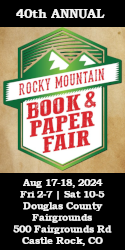Walking on Water in Venice
Last week we returned from a short trip that included visits to Rome, Florence, Venice, and smaller towns en route. In one sense we’re fairly experienced travelers, having lived in Spain for a short time in the 1970s, since then visiting England and/or Spain occasionally to visit friends, relatives and business associates. We’ve always tended to stay in the same old groove – some people would call it a rut.
Except for a Granada-based, Easter vacation tour of northern Morocco in 1974, this was the first time we'd ever joined an organized group but since it was our first visit to Italy we thought it would be a good idea to sign up with a Globus tour that would give us an introduction to a country we’d never been to before, while allowing us time to visit some great libraries and bookstores.
Some friends of ours who run Utopia Books (and the Horned Dorset Inn) in nearby Leonardsville loaned us a small stack of guide books, mostly focusing on Tuscany where Kingsley had spent a summer some years ago while an art student in Florence and where he and his wife, Roberta, return whenever possible.
I must confess that I barely looked at the books before we left – there was so much information overload it was hard to know where to begin. Now that we’ve returned, these same books have become much more interesting as we compare our own experiences with the descriptions and opinions of others.
Maybe I did the whole thing backwards but then I’m the kind of person who, when confronted with the job of assembling a low or high tech gadget, tends to glance at the directions briefly and immediately jump in with both feet and let my intuition take over. When I eventually get stuck, which is most of the time, I begin reading the instructions seriously – more often than not phrased in some Chinese technical writer’s version of English.
Standard travel guides and travel narratives have obvious differences but are similar in that both attempt to convey a sense of place – but when they’re really successful they give us a combined sense of time and place. Travel or tourist guides try to cover all the bases – travel narratives tend to be highly personal. Editorial Everest (León) publishes guides for tourists in Spain (they once hired us to translate Seco de Lucena Paredes’ El Albayzin into English) – Washington Irving and Friedrich Hacklander wrote travel narratives, although one could easily argue that The Alhambra is also a work of the imagination.
*
Peter Besas, an old school chum of Bern Marcowitz (CCNY), was involved in the travel business for many years (as was Bern) and has been living in Spain more or less permanently since 1965. He was born in Germany and as a child moved to New York with his family in 1940 by way of Oslo, on a ship that also carried the entire Norwegian gold reserves – departing only four hours before the Nazis invaded that country (fortunately a pursuing German U-Boat never found them). After university and before moving to Spain permanently, Peter and Bern bummed around Europe for a year and when the money ran out they returned to New York.
Several months ago Mr. Besas’ Compendium of German-Language Books of Travel in Spain (1750-1900) was published by Ediciones La Librería in Madrid. Irrespective of subject matter, an actual ink-on-paper and cloth-bound reference book on any topic is something of an anomaly these days.
Actually, Compendium... is not a reference book in the sense that an encyclopedia is a reference book.
Encyclopedias, especially scientific ones, were out-of-date as soon as they were published. Good author or subject bibliographies, especially those with personal annotations, can be as timeless as a vintage photograph.
In his Introduction, Mr. Besas writes:
Rather than simply providing bibliographical data on the books surveyed, I have endeavored to provide synopses of the contents of each, stating the subjects that each traveller chose to write about and noting... the approximate space allotted to a given subject or tourist site... I have concentrated on the facets and details of travel itself, though I have also noted when the authors comment on matters of politics, history, military operations, religion, bullfighting, fine arts and dozens of other subjects...To my mind, at least, Wolzogen’s detailed description of a diligence is worth infinitely more than Parlow’s 27 pages of artistic effusions on the paintings in the Prado...
Each entry includes a bibliographical description annotated by synopses of varying length, estimation of literary value, degree of rarity, monetary value, location symbol, and “Peter’s View” or personal appraisal of each book. He clearly values detailed descriptions of ephemeral situations – “Rochau often throws in fascinating asides, such as... a superb description of the ordeal involved in crossing the Besós River with his diligence, with no bridge available...”
Before writing Compendium, Mr. Besas had been the editor-in-chief of an English language magazine in Madrid, the Madrid Bureau Chief for Variety (the show business newspaper) and author of several books relating to Spain including The Written Road to Spain, (about 19th-century travellers in Spain), Behind the Spanish Lens (the first book in English about Spanish cinema), Hidden Madrid I (now in its sixth edition) and Hidden Madrid II).
Compendium is clearly a labor of love intended for the few people who still have a soft spot for reference-type books in general or Spain in particular. The book is available on Biblio.com or you may contact the author directly at besas@germancompendium.com
*
I cut down the last of our dahlias on October 31st, the day before we left for Italy. We’d dodged light frosts right up to the end and it was really tough digging them up while they were nearly in full-flower. The harvest of tubers for next year’s display was rather plentiful so there’s a good chance (if they all survive storage) we’ll have some extras to share with other dahlia fanciers. If you’re interested and within easy driving distance, get in touch with me sometime in April.
Nearly everyone I know who has spent time in Florence has commented that in addition to all it’s known for, it has the added good fortune to be situated in one of the most beautiful parts of Italy – a few miles away lie the Tuscan hills and some of the hottest real estate in Europe.
There’s often a long line of people waiting to get tickets to visit the Uffizi so once inside you feel you have to see everything – but visiting a world-class art museum the way some people pig out at an all-you-can-eat buffet is not a good thing. The information overload can be overwhelming and the equivalent of artistic indigestion. I particularly liked Botticelli’s Primavera, Birth of Venus and the more secular paintings, but the special exhibition of Caravaggio and his contemporaries was a little too bloody for my taste. I think the Caravaggio time would have been better spent at Gonnelli’s.
Libreria Antiquaria Gonnelli, located on Via Ricasoli, a short walk from the Piazza del Duomo, was founded in 1875, is as solidly upmarket as any bookshop I’ve ever been in and, I would guess, as worried about competition from the Internet as the Horned Dorset is about competition from McDonald’s or Burger King. The three branches of the business include the impressively-appointed antiquarian bookshop, an auction house, and a workshop specializing in fine binding and other book arts. Gonnelli’s may not fear competition from the Internet, but the Internet (www.gonnelli.it) will allow you to peek inside and get an idea of what awaits.
The Medicis ran a pretty tight ship and after returning from Florence I checked out my copy of Statuta Concilii Florentini [Florentiae, Bartholomaeum Sermartellium, MDLXIIII (1564)] using what’s left of my high school Latin to translate some of the strict laws that were to apply to both citizens and clerics. The index preceding the text (law printed in red, explanation in black) includes entries such as “Blasfemia quomodo punitur”(p.19), “clericorum retinentium concubinas aut suspectas mulieres monasteria” (p.5), “clerici retinentis pueros suspectos & infames poena” (p.6), etc.
My vellum-wrapped copy with the coat of arms of the Medici family in the center of the title page (in case there was any doubt about who was in charge) is not for sale but Sokol in London has one on offer for £2250.00. (http://www.sokol.co.uk/Book.aspx?id=15343) His description reads in part as follows:
The Medici had returned to Florence only five years earlier, with Spanish backing, but their fortunes were greatly enhanced by the creation of Giovanni di Medici Pope Leo X. Divided into 34 main subject headings, the decrees cover the punishments for a variety of sexual or financial transgressions, including a multitude of carnal sins by priests (even mentioning incest), sodomy and the prostitution of boys, blasphemy, apostasy, simony, usury, and the law relating to wills, money lending, trade, judicial proceedings etc, with one condemning printers in the city who publish without licence....all the clergy and laity of the Diocese were bound by its acts, following their promulgation ....the enumerations of the sins of the Florentine populace in the pronouncements of the Synod give a lively picture of the timbre of life in the city at the turn of the sixteenth century, and the moral state of the clergy, above all....
With all the uproar about scandals in the Catholic Church, the financial dealings of Bernie Madoff, investment bank bilking of taxpayers, and recent charges that WikiLeaks1 is trying to publish the real news without permission, shows that not much has changed in 500 years.
*
It was very wet in Venice. An extended period of rain, higher than normal tides, and a stiff breeze coming off the lagoon, allowed photo-journalists to run pictures of people walking around St. Mark’s Square on raised cat-walks. I thought it all had to do with global warming but locals told us it’s been going on for hundreds of years because whenever the government agrees on a good solution, there’s a political change and plans are put on hold. Someone suggested they just put the Dutch in charge.
The Biblioteca Nazionale Marciana (Biblioteca di San Marco) in Venice was founded around 1454, shortly after the completion of the building that was constructed to house pre-existing collections-in-waiting as well as later donations of important rare books and manuscripts. In 1603 it became a “national” deposit library similar to the Library of Congress and other national libraries that receive copies of every book published within their jurisdictions. Since Italy didn’t exist at the time, the law applied to books published in the Venetian Republic.
According to Orsola Braides, the cataloger of musical manuscripts, printed music and engravings, the Marciana is part of a network of forty-six state libraries, ten of which are national. By most standards the collections are not huge, printed books numbering anywhere from 500,000 to 1,000,000, depending on the source of the estimate, but its holdings of around 5,000 incunabula and 12,000 early manuscripts make the library an important center for research.
Venice proper has only 60,000 or so permanent residents, but plays host to close to 20,000,000 visitors a year, most of them passing through Piazza San Marco (St. Mark’s Square), also famous for outdoor cafes that will sell you what some people say is the most expensive cup of coffee on the planet. (equally good coffee for a fraction of the price is available on many of the side streets) At any rate, many of these cafes are set up just in front of the Biblioteca di San Marco and one must wonder how many of the 20,000,000 visitors who pass by know of its existence.
- According to one of our correspondents the current “motherload” of WikiLeaks servers is http://geeksisland.com/wikileaks-new-updated-addresses/

























